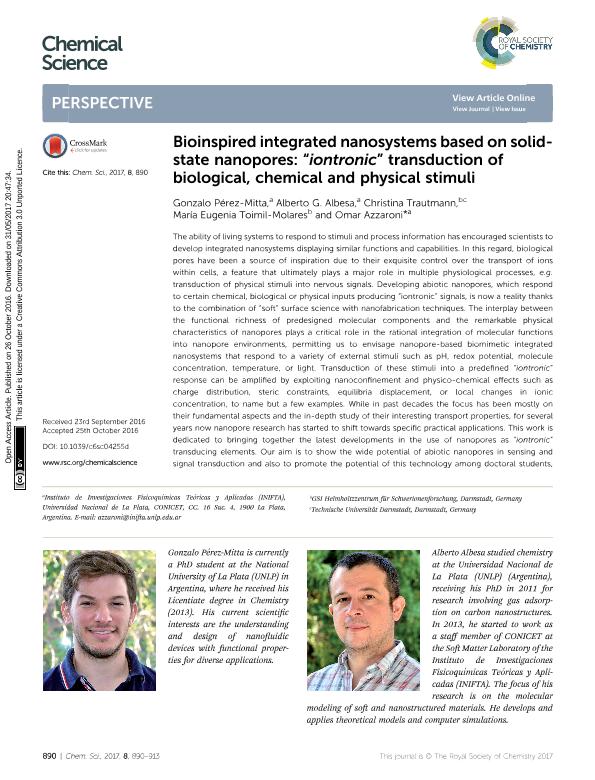Artículo
Bioinspired integrated nanosystems based on solid-state nanopores: “iontronic” transduction of biological, chemical and physical stimuli
Perez Mitta, Gonzalo ; Albesa, Alberto Gustavo
; Albesa, Alberto Gustavo ; Trautmann, Christina; Toimil Molares, María Eugenia; Azzaroni, Omar
; Trautmann, Christina; Toimil Molares, María Eugenia; Azzaroni, Omar
 ; Albesa, Alberto Gustavo
; Albesa, Alberto Gustavo ; Trautmann, Christina; Toimil Molares, María Eugenia; Azzaroni, Omar
; Trautmann, Christina; Toimil Molares, María Eugenia; Azzaroni, Omar
Fecha de publicación:
03/2017
Editorial:
Royal Society of Chemistry
Revista:
Chemical Science
ISSN:
2041-6539
Idioma:
Inglés
Tipo de recurso:
Artículo publicado
Clasificación temática:
Resumen
The ability of living systems to respond to stimuli and process information has encouraged scientists to develop integrated nanosystems displaying similar functions and capabilities. In this regard, biological pores have been a source of inspiration due to their exquisite control over the transport of ions within cells, a feature that ultimately plays a major role in multiple physiological processes, e.g. transduction of physical stimuli into nervous signals. Developing abiotic nanopores, which respond to certain chemical, biological or physical inputs producing “iontronic” signals, is now a reality thanks to the combination of “soft” surface science with nanofabrication techniques. The interplay between the functional richness of predesigned molecular components and the remarkable physical characteristics of nanopores plays a critical role in the rational integration of molecular functions into nanopore environments, permitting us to envisage nanopore-based biomimetic integrated nanosystems that respond to a variety of external stimuli such as pH, redox potential, molecule concentration, temperature, or light. Transduction of these stimuli into a predefined “iontronic” response can be amplified by exploiting nanoconfinement and physico-chemical effects such as charge distribution, steric constraints, equilibria displacement, or local changes in ionic concentration, to name but a few examples. While in past decades the focus has been mostly on their fundamental aspects and the in-depth study of their interesting transport properties, for several years now nanopore research has started to shift towards specific practical applications. This work is dedicated to bringing together the latest developments in the use of nanopores as “iontronic” transducing elements. Our aim is to show the wide potential of abiotic nanopores in sensing and signal transduction and also to promote the potential of this technology among doctoral students, postdocs, and researchers. We believe that even a casual reader of this perspective will not fail to be impressed by the wealth of opportunities that solid-state nanopores can offer to the transduction of biological, physical and chemical stimuli.
Palabras clave:
Solid-State Nanopores
,
Iontronics
,
Ionic Rectifiers
,
Nanoscience
Archivos asociados
Licencia
Identificadores
Colecciones
Articulos(INIFTA)
Articulos de INST.DE INV.FISICOQUIMICAS TEORICAS Y APLIC.
Articulos de INST.DE INV.FISICOQUIMICAS TEORICAS Y APLIC.
Citación
Perez Mitta, Gonzalo; Albesa, Alberto Gustavo; Trautmann, Christina; Toimil Molares, María Eugenia; Azzaroni, Omar; Bioinspired integrated nanosystems based on solid-state nanopores: “iontronic” transduction of biological, chemical and physical stimuli; Royal Society of Chemistry; Chemical Science; 8; 2; 3-2017; 890-913
Compartir
Altmétricas



